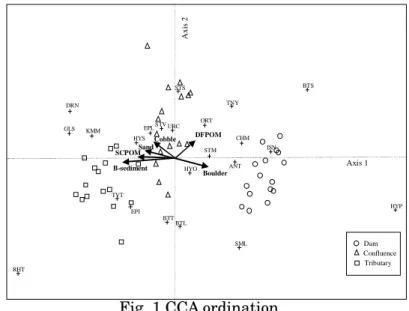Effects of a tributary on macroinvertebrates at the downstream of
Yahagi-dam.
Akira Takao
Key words: macroinvertebrate, river, dam, tributary, dam, substrate, TWINSPAN, CCA
1. INTRODUCTION
Dams are a common feature of stream and river systems throughout the temperate zone. It should come as no surprise that the modification of flow caused by dams alters the structure and function of river ecosystem since
water flow governs the fundamental nature of streams and rivers. Then, managements of dams need to be
improved considering such environmental perspectives of dams. However, decisions toward biological
conservations are complex in no small part because vast scientific uncertainty still exists especially in Japan, as little quantitative observation is made. Tributaries are expected as a major source of recovery in river system but
that is still ambiguous. Therefore, macroinvertebrate assemblages at three reaches (dam: downstream of the dam,
confluence: downstream of the confluence, and tributary) were sampled to confirm the impact of long-term
impoundment and the role of a major tributary (Akechi River) in community shift.
2. METHODS
Research was conducted around Yahagi-Daini Dam (dam wall 38m high), central Honsyu, Japan from10 to
21 February 2004. Four Surber samples and associated physical measurements (depth, velocity, substrate
composition) were taken from four riffle zones at each study reach. Drifting materials (POM and bedload
sediment), and periphyton were also sampled. These variables were first analyzed with one-way ANOVA to
assess differences among reaches, then TWINSPAN classification and CCA ordination were made to examine
differences in fauna among reaches related to environmental variables.
3. RESULTS AND DISCUSSION
Dam Confluence Tributary
DFPOM Cobble Sand SCPOM
B-sediment
BTT BTL
SML
HYP TVT
EPI GLS
STS
URC
BTS
ISN TNY
CHM
ANT STM ORT
RHT
HYO STV EPL HYS DRN
KMM
Axis 1
Axi
s 2
Boulder
Fig. 1 CCA ordination
Significant differences in the macro-
invertebrate fauna among reaches were
observed. Dam faunas were severely altered
with high macroinvertebrate abundance and low taxa richness in contrast to those in the tributary.
TWINSPAN classification clearly distinguished
dam samples from those from the confluence
and the tributary. Based on CCA ordination, these differences in community structure
reflected changes in substrate composition, and
quantity and quality of FPOM (Fig.1). Our
observations suggest that while reduced flow
and sediment transportation had a great impact
on the fauna, a major tributary acted as a source of sediment. Further empirical and conceptual studies about the
